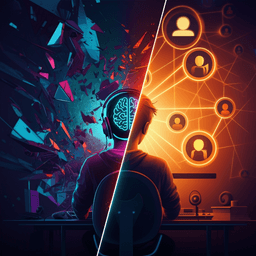
Psychology
From “online brains” to “online lives”: understanding the individualized impacts of Internet use across psychological, cognitive and social dimensions
J. Firth, J. Torous, et al.
Drawing on large-scale epidemiological studies, randomized trials, systematic reviews and qualitative research, this paper offers a multi-dimensional overview of how Internet use influences mental health, cognition and social functioning across ages, genders and usage types — research conducted by Authors present in <Authors> tag.
~3 min • Beginner • English
Introduction
This special article updates the 2019 World Psychiatry review on the “online brain” by evaluating how the Internet, now further embedded in daily life, influences mental health, cognition, and social functioning. The paper synthesizes newly available large-scale epidemiological data, systematic reviews, randomized controlled trials, neuroimaging, behavioral studies, and qualitative research to provide a multidimensional perspective. It aims to move beyond simple metrics of time online to understand individualized and contextual determinants (age, gender, vulnerability factors, and specific usage patterns) of psychological and cognitive outcomes, and to consider emerging domains such as culturomics, virtual/augmented reality, and artificial intelligence.
Literature Review
The article provides a narrative synthesis across diverse literatures: large epidemiological analyses showing minimal or nonlinear associations between total digital engagement and mental health; RCTs testing social media abstinence with mixed results; qualitative studies detailing experiential aspects of compulsive engagement, FOMO, and algorithmic reinforcement; neuroimaging (ABCD study) showing limited causal links from screen media to brain connectivity, but activity-specific correlations with cognitive performance and brain structure; behavioral momentary assessments highlighting person-specific distraction patterns and habitual use; lifestyle and time-use epidemiology supporting displacement hypotheses (sedentary time and sleep affecting cognition); social cognition research on empathy, social feedback, echo chambers, and contagion; culturomics revealing diurnal mood rhythms and accelerating attention decay; and emergent work on VR/AR and AI for social training and mental health interventions, including avatar therapy and risks (Proteus effect, privacy, safety).
Methodology
This is a narrative, integrative review updating prior work and synthesizing findings from multiple sources: large-scale epidemiological datasets, systematic reviews and meta-analyses, randomized controlled trials, qualitative studies, neuroimaging cohorts (e.g., ABCD), time-use epidemiology, and culturomics analyses. The paper does not specify formal search strategies, inclusion/exclusion criteria, or quantitative synthesis protocols; rather, it aggregates and interprets recent evidence to provide a multidimensional overview of individualized impacts of Internet use across psychological, cognitive, and social domains.
Key Findings
• Overall screen time shows limited direct causal links to mental health, with large datasets reporting minimal associations; a U-shaped relation is suggested in some cohorts (e.g., 1–2 h/day associated with better psychosocial functioning than very low or high engagement). • RCTs of social media abstinence/limits present mixed outcomes: a 2023 systematic review of 23 RCTs found medium-to-large reductions in depression in 7/10 trials, some benefits for anxiety (3/6) and small or inconsistent effects on wellbeing (3/8); other preregistered experiments reported null effects, and some trials found decreased life satisfaction or increased loneliness with abstinence. • Prevalence of social media addiction, under strict classifications, is ~5% across 32 nations (>34,000 individuals). • Qualitative data highlight engagement facilitators (notifications, auto-scrolling, recommendation algorithms), compulsive checking, and difficulties in self-regulation; users report strategies to reduce use (muting, alarms, removing apps), especially during emotional vulnerability. • Social benefits coexist with risks: social media can maintain connections (notably aiding older adults and youth during COVID-19 lockdowns), yet also fosters FOMO; RCTs have shown reduced FOMO after short abstinence in one study, but no effect in another. • Social comparisons online can reduce self-esteem and influence body image and eating/weight disturbances via internalization of ideals and upward comparisons; meta-analyses support cross-sectional, longitudinal, and experimental associations. • Cognitive mechanisms may include inhibitory control deficits and attentional biases; neurocognitive parallels observed between excessive social media use and food/binge-eating disorders. • Brief experimental exposure to body neutrality content (TikTok) improved body satisfaction and mood versus idealized physique content. • Attention and cognition: parent-reported data from >2,300 preschoolers link >2 h/day screen time to ~6x higher odds of clinically significant inattention and increased ADHD symptoms; however, an RCT reducing social media by 50% for 1 week found no attention improvements versus a 10% reduction control (actual control reduction 38%). • Neuroimaging (ABCD, N≈11,878, ages 9–10 at baseline): no consistent causal relations between screen media usage and functional connectivity over 2 years. Activity-specific findings (N≈4,277): video watching/gaming linked to maturation in visual systems and gaming to greater orbitofrontal volume and higher fluid intelligence; social media use negatively related to crystallized intelligence. • Momentary assessments show individual variability in which apps/platforms trigger procrastination; task delay relates more to habitual/automatic use than check frequency. • Displacement hypothesis: sedentary online time may reduce physical activity and impair sleep, both linked to poorer cognition; meta-analyses and reviews associate higher sedentary behavior with reduced cognitive function and increased dementia risk; mentally active sedentary behaviors (computer use, some gaming) relate to better cognition vs mentally passive (TV/video). UK Biobank data show global cognition inversely associated with passive sedentary (TV) and positively with active sedentary (computer), in healthy controls and bipolar disorder patients. • Screen use before bedtime relates to poorer sleep quality, slower reaction time, and reduced attention, particularly mornings; blue light disrupts melatonin and sleep; blue-blocking interventions may help. • Adherence to 24-hour movement guidelines (physical activity, screen time, sleep) associates with higher global cognition and greater cortical/subcortical volumes in children, and fewer cognitive difficulties in adolescents; adherence is low globally. • Social cognition: social media/online games can train perspective-taking and empathy, but may also foster competitive/aggressive behaviors; evidence linking gaming to social cognition is limited and mixed. • Online information ecosystems shape exposure via social networks, creating echo chambers and polarization; emotions and behaviors can spread through complex contagions, with implications for decision-making. • Culturomics reveals diurnal patterns in mental health information seeking (depression-related searches peaking at night) and accelerating collective attention dynamics with shorter attention half-lives across platforms, relevant to public health messaging. • VR/AR and AI: immersive environments may enhance social skills and enable personalized exposure therapies (avatar therapy), but risks include privacy, safety, potential addiction, and Proteus effect (small-to-medium behavioral conformity to avatar traits). Early metaverse adoption appears low (e.g., Decentraland reported ~38 daily users; only ~9% of user-created worlds visited by >50 unique users), but technologies may evolve; stakeholders show mixed views on AI in care.
Discussion
The review advances understanding from time-based metrics toward individualized, context-dependent models of how Internet use affects mental health, cognition, and social functioning. Evidence indicates that outcomes depend on developmental windows (age, gender), offline vulnerability factors (loneliness, family dysfunction, disability), and specific usage patterns (e.g., passive vs active engagement, habituality, algorithms). Cognitive findings challenge a uniform detriment narrative: certain activities (gaming, mentally active sedentary behavior) can correlate with favorable cognitive markers, while others (passive video/TV, sleep disruption) associate with impairments. Psychological effects are bidirectional: online social connection can reduce isolation and support wellbeing, yet FOMO, social comparisons, and compulsive feedback loops can undermine self-esteem and mental health, especially in susceptible groups. Culturomics offers tools to understand societal-level attention and mood dynamics relevant to public health strategies, while emerging VR/AR/AI modalities show promise for personalized therapies and social skills training, tempered by ethical, safety, and bias concerns. Overall, the findings emphasize personalized guidance and interventions that consider an individual’s online behaviors, offline lifestyle (activity and sleep), and psychosocial context, rather than treating Internet use as uniformly good or bad.
Conclusion
Internet use has multifaceted, individualized impacts across psychological, cognitive, and social domains. The paper encourages moving beyond binary evaluations to a nuanced view that recognizes simultaneous benefits and risks shaped by usage type, user characteristics, and context. It highlights opportunities to harness positive aspects (social connection, education, mentally active engagement, targeted interventions via VR/AR/AI) while mitigating harms (compulsive use, FOMO, adverse social comparisons, sleep disruption, sedentary displacement). Culturomics provides population-level insights into attention and mood cycles that can inform public health messaging. Future research should adopt fine-grained, cross-disciplinary approaches; clinical, policy, and guideline efforts should integrate neuroscientific, behavioral, and societal evidence to support individualized, evidence-driven digital engagement.
Limitations
As a narrative review, formal systematic search methods and quantitative synthesis are not specified, which may introduce selection and interpretive biases. Many cited associations are observational, limiting causal inference; RCTs yield mixed results and often short durations. Measurement challenges (self-report, heterogeneous definitions of screen time and usage types) and confounding (sleep, physical activity, socioeconomic factors) complicate interpretation. Culturomics analyses face caveats including uneven Internet access, language/cultural biases, data availability/decay, property rights, and privacy constraints. Evidence on VR/AR/metaverse mental health impacts and potential addiction is nascent; the Proteus effect may produce unintended outcomes. Generalizability across ages, cultures, and platforms is uncertain; more rigorous, longitudinal, and experimental work is needed.
Related Publications
Explore these studies to deepen your understanding of the subject.







